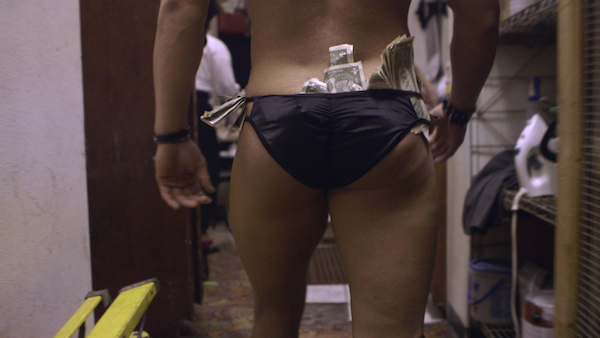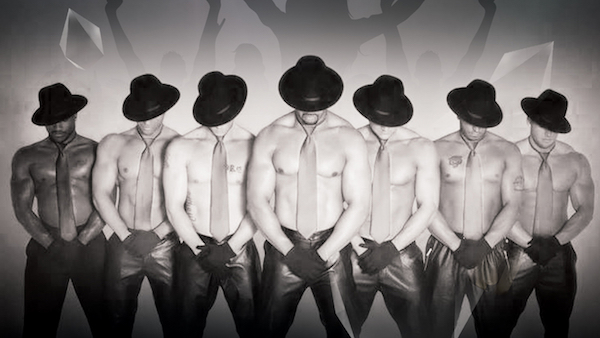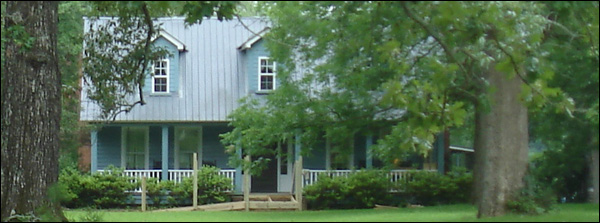The Almost Naked Dancers of The Lone Star Cafe
“My friends, Cliff and Jim, had come to the ecdysiastical profession at different times. Jim had been dancing—and stripping—on stage in New York for several years. He had learned from some of the biggest names in the business: Damian, Thor, and, most famous of all, Scorpio. I had seen Scorpio perform, and his fame was justly earned. Jim had learned from Scorpio, and become a no-nonsense professional about his work, always trying to find ways to improve his performance.”—William A. Balk, Jr.
Epicurus’ Porch
By William A. Balk, Jr.

BEAUFORT South Carolina—(Weekly Hubris)—5/9/2016—The video clip shows a comely couple in a choreographed ballet, dancing nude; expertly piloted drones carry sheets of paper to obscure the naughty bits from view, adding a further dimension to the elegant moves of the dancers. It is the one glaring incongruity which draws the attention of the observant Facebook poster, however—the male dancer’s calf-high black socks. Startling! Whoever posted the video on Facebook doubtless has seen much of the world and is certainly a sophisticated observer of cultural nuance, but it seems to me that her experience has not prepared her for a nude-but-for-the-socks ballet dancer. I, on the other hand, had the explanation from my own worldly explorations.![]()
Washington, DC, was my home for a period of time stretching from my early adulthood into a youthful middle age. Cities are often superb mixing pots, offering opportunities and friendships across boundaries which, in less dense settings, can sometimes be quite difficult. I was often a guest at grand embassies; I dined with agency heads and with painters and sculptors; among my most relied-upon friends were servers at restaurants and ushers at the theaters. Several friends I got to know were living homeless on the streets, and a few even made their living walking those same streets.
For some years, I was quite close to a young couple who were professional go-go boys—Oh, hell, they were strippers!—at a remarkable downtown bar just a block from the FBI building. The FBI, by the way, were the owners of the building and the landlords of the strip club, due to some much earlier shenanigans by former club owners and a philandering congressman, and seizures of property and other complications. The courts had ruled that the former Mafia owners must relinquish their wicked property, and the FBI found itself the new owner and manager. For years. They never seemed to find a way to rid themselves of the Lone Star Steak House, so it lived on under the benevolent protection of the Feds instead of the Mob.
Anyway, my friends, with whom I played a weekly game of cut-throat Scrabble for a couple of years, danced for tips—very good tips—at night. During the day, the Lone Star was still a strip club, but there were charming ladies who danced then, some of whom also became my good friends. The transition between the club’s daytime stripper persona and its night time go-go boy persona occurred at around 6 p.m., with a mad rush of ladies trying to dress and get out quickly, dazed men in business suits unsure what was going on, and young men in very tight jeans swarming in and quickly running to the filthy basement to change into their performing costumes.
The Lone Star Steak House, in order to operate under DC’s licensing laws as a bar and nightclub, was compelled to serve food. Before I became familiar with the place, I once tried to order a steak. The server laughed at me, but was able to come up with some French fries. I still don’t know if they fired up a fryer in a back room or if someone ran down the street to get take-out from the greasy spoon several doors away. I think I paid five bucks for those fries.
After I became a regular, I got to know everybody and was sometimes, despite official management orders, allowed into the warren of clammy basement rooms and stairways which served as the performers’ dressing and break rooms. It was all pretty bare, it seems to me now: bare brick walls, bare concrete floors, bare light bulbs hanging from bare wires. There was no room for a kitchen, per se, but I do remember a corner set aside with a pair of banged-up sinks and a two-burner hot plate. I never did try to order food again.
The performers had to use these back room niches to change from street clothes into their stage outfits. For strippers, perhaps ironically, clothing is vital. It is how they convey to their audience the personalities of the characters in their performances. It must also be practical; that is, it must be easily removed and embody a certain flair appropriate to each character. And it may well be true that cowboy boots may be striking on a nearly naked stripper, but there is no way to get one’s pants off elegantly while wearing boots: so, boots are out.
The strippers would crowd into the club’s dank downstairs corners, using their backpacks or duffel bags as costume racks, luggage, makeup kits, and safes for holding valuables. There was a cubbyhole with a rust-stained toilet, a mirror, and a sink with one cold-water faucet; the floor, cold concrete. Here they might wait for the call just before their next set began, or they might go back upstairs and sit with friends or favorite fans.
The fans at the Lone Star—at least, the after-6 fans—were often regulars. Many of us got to know each other well. One brilliant and charming man I first met as a writer, I eventually learned was a very celebrated historian and presidential biographer. For years afterward, I would sometimes hear from him when a new book was coming out. Another couple, who had taken on the role of stage mothers for the young performers, were dealers in antiquities in Washington, Philadelphia, and New York. It was a neighborhood bar, not unlike the bar in Cheers, where everyone knows your name.
The rest of the crowd at night was there for the show. Well, all of us were there for the show but, for some of us it was like going to see your little brother in the high school play. Sort of.
My friends, Cliff and Jim, had come to the ecdysiastical profession at different times. Jim had been dancing—and stripping—on stage in New York for several years. He had learned from some of the biggest names in the business: Damian, Thor, and, most famous of all, Scorpio. I had seen Scorpio perform, and his fame was justly earned. Jim had learned from Scorpio, and become a no-nonsense professional about his work, always trying to find ways to improve his performance.
Cliff was a few years younger than Jim. A country boy from near Aiken, South Carolina, cast out by his family, he made his way to Washington, where he met Jim and fell in love. Cliff decided he could learn to dance from Jim and help with family finances. As good as Jim was, Cliff was becoming as much of a star, if not yet quite so polished a dancer, as Jim was. Jim was very proud of Cliff.
Cliff and Jim filled me in on the various short-cuts and maneuvers strippers employed to make themselves stars—or to keep themselves safe, or to make themselves some money. The Lone Star’s stage was tiny, about six feet square, with a smooth wooden floor. Cliff and Jim were both quite athletic, which was one of the reasons for their success, of course, and they incorporated their skills into routines which involved leaping off the stage and performing among the cheering crowd, on tabletops, on the floor, on the bar, even on chairs, while they were occupied. As you can imagine, such close proximity to excited fans could become risky. I was often selected, as a trusted member of the audience, to assist in some of the more exotic and difficult dance moves, such as Cliff’s inverted hula, performed in the lap of an audience member.
The stage had two sturdy steel poles at its front corners, which were used for all the usual pole-dancing routines taught to middle-aged mothers in exercise classes, as well as more exotic and athletic moves dreamed up by each dancer for his performance.
The dancers wore outfits to suggest a particular character or image for their performance. Too many layers took too long to get rid of and made the crowd angry, so costumes often amounted to a hat (cowboy hat, construction helmet, baseball cap) or, for some, a more glittery or feathery head covering; a shirt (cowboy shirt, cop shirt, a sleeveless t-shirt), a leather vest, or a sparkly midriff-baring jacket; pants (jeans—often ripped, leather chaps, riding breeches), shorts (very, very short cut-off jeans), or billowy harem pants.
Below this outerwear, most wore a jockstrap or a very plain g-string. Some wore sequined g-strings, but jockstraps were most common.

These were the heady days when it was still somewhat sensational for nude dancers actually to strip completely. The laws no longer forbade it, but many strip bars would not let their dancers bare all. Some jurisdictions did seem to enforce codes that apparently prevented such nudity, but the FBI overseers and the DC police never once threatened the Lone Star for its nudity.
The jockstrap, then, or the g-string, was the last refuge of the tease. Timing was essential for the dramatic reveal in those first years. A dancer had to delay the release of the jockstrap or the g-string until just seconds before the performance ended, and then quickly leave the stage to calls for more. Those days marked the end of the artistic performances, however. Very soon, dancers realized that the newcomers who had decided to shed all much earlier in the routine were getting many more tips than the ones who allowed only a peek at the finale.
Pretty soon, the costumes diminished in significance, in coverage, and in longevity over the course of the performance. The artistic ecdysiasts had to adapt, and they quickly did, for it meant survival. Within weeks, all the dancers would begin their routines as usual but, within three minutes, would be as naked as when they came into the world. This kind of performing, which required dancers to discard their wearable props early on, also required new ways of moving about and new kinds of vigor to remain at peak performance (as it were). The competition became quite stiff, and only some performers were up to the challenge.
The site of the old Lone Star is now subsumed into the facade of one of the megalithic office structures that have spread over DC. The name, interestingly enough, was acquired by a restaurant-and-bar chain with several locations in the suburbs of Washington, though none has the character and community spirit the old dive offered.
Oh, the socks!
Three things: one, it was cold. Socks kept the feet, at least, warm; two, the stage had a wooden floor (splinters) and socks move more easily over wood than do bare feet; and three, where were the fans supposed to put their tips? In the socks, since that’s all that was left. (I’m not sure tips were at issue in the ballet video clip recently posted on Facebook, though).
The socks were invariably white athletic socks, above the ankle. My dancing friends would have agreed that black socks would be . . . distracting.
![]()
(PS: Thanks to Cliff and Jim, kind and gentle and good men, both, and to the late Hugh Gallagher)


11 Comments
Eddie Mac
Your writing and life experiences are quite exquisite. You are a gift to the low country. Keep pursuing your passion!!
Will Balk, Jr.
LOL! Eddie Mac, I thank you for your kind words! And I believe I just saw a photo of you sans beard. . . took twenty years off! Jamelle’s pleased, I’m sure.
lolita
Will Balk, I am continually amazed — and entertained — by your writing and experiences…thanks so much for sharing…on so many topics!!…white socks…but of course!!!
Mary Laura Jones
Always great to hear your voice. I miss just hanging out with you. Keep writing more. It is such a joy to read what you have written.
Judy
Dear Will,
I have always loved your honesty & understanding, & this piece was such a joy to read, thank you.
Teresa Bruce
You should review dance for the NYT — some honest admiration of skills ordinary people do not possess would be a welcome reprieve from the banalities of self-congratulatory criticism. Well done!
Will Balk, Jr.
Lolita, I always feel a special tingle when you leave a comment on here! Thank you! And thank you, too, Mary Laura. . . I keep thinking I may be able to write a little about those very special days of innocence we all shared so many years ago…who knows? Judy, love, you make me blush (and after this piece, that may seem really odd!) Teresa, dear heart, I miss having you and Gary downtown, readily available for a bit of biting criticism, NEVER self-congratulatory! And you’re right – if not necessarily about my critical abilities for understanding dance, certainly about my awed respect for those blessed with unusual gifts of skill and knowledge. And with such gifts as well, Cliff and Jim both exemplified generosity toward all and compassion toward others less fortunate. I would not have held them so fondly in memory otherwise. Thanks to all you unusually perceptive readers! ;>)
Judy Pearce
You were a pretty good dancer back in the day, Will, with your pants down below your belly button ~:)
Will Balk, Jr.
lol, Judy Pearce! “Back in the day” is so long ago now, I will simply trust your recollection!
Anne Roberts
“Back in the Day” at BST on Bay , after vacuuming and a rare slow morning start, I caught a glimpse of your DC life. Then the rush of Conroy fans, neighbor/customer shoppers. or Chris’ “let’s rearrange the shelves” projects interrupted the full picture. How fine that you wrote this artful, exciting, nostalgic detailed piece for the “Weekly Hubris”.
Will B
Speaking of nostalgia, Anne, that recollection of the start of a typical day in the bookstore is poignantly evocative. Thank you for remembering that moment.